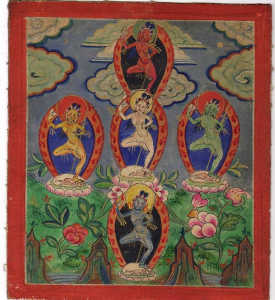Diversity Dakinis
Diversity is beautiful
Diversity is the norm
Appreciating diversity helps us live more wakefully
Diversity awareness helps us live more compassionately
Dakini Mountain is dedicated to celebrating diversity
Dakini Mountain is named after the Dakini principle because this term – Dakini – expresses the principle of diversity in creative expression that is the phenomenal world. The notion of Dakini in the Great Perfection (Dzogchen) goes hand in hand with the teachings of the five elements and the five wisdoms. Each of these are represented by a variety of enlightened female figures, known as Dakinis, the Five Wisdom Dakinis.་They are different colors, different body shapes and different personalities thought to represent the spectrum of wisdom qualities in human beings – joy, clarity, dignity, fearlessness and peace.
Dakini is the Sanskrit term and the Tibetan word is mkha’ ‘gro, which means traveling in the sky. It can also be rendered as traveling in space. One popular rendering is “sky-dancers.” The space and sky that the Dakini travels in – is the space of reality as it is.

A mandala of the Five Wisdom Dakinis, with the unusual feature of the Red Dakini in the North, even though we most commonly see the white or blue one in the North. Another case where Tibetan Buddhism’s number one rule is – Diversity.
According to the Great Perfection (Dzogchen), every living thing communicates special qualities of this Dakini wisdom. It is communicated in qualities such as spaciousness and energy, or power and intimacy. Usually we think of such qualities as contradictory or oppositional. However, in nature we see contradictory qualities co-existing to express extraordinary beauty. The Lotus Dakini wisdom is present as the luscious beauty of nature. The Jewel Dakini wisdom is present as the overwhelming power of nature, its nobility and dignity. The Vajra Dakini wisdom is present as the clarity and decisiveness of nature, its intensity and intelligence. The Buddha Dakini is present as the spacious accommodating quality of the sky, its stability and openness. The Karma Dakini is present as the quality of change, of action, activity and accomplishment. In Buddhist meditation practices featuring the five wisdom dakinis, their mandala implies an opening to the diverse qualities of enlightened wisdom that drive the phenomenal world. Therefore, when we appreciate the sacred wisdom of the Dakini principle, we befriend our world and therefore we can be friend the basic ingredients of own minds.
Sometimes Buddhist discourse is used to perpetuate entrenched power structures by denying diversity. One major is example is using emptiness discourse to deny diversity discourse. For example – the idea that if one is a Buddhist one should not be a feminist, because gender is empty. However, this logic is faulty, because if all identities are empty and therefore useless in their emptiness, then one one not need to even identify as a Buddhist. On the contrary, identifying as a Buddhist is useful. According to Mahayana thinking, identities fall into the category of conventional truths, functional, but contingent truths that have useful effects when they are used. This notion of emptiness is talked about in divergent ways according to differing schools of Buddhist philosophy. (Truly, the number one rule of Tibetan Buddhism is diversity). In the Great Perfection (Dzogchen) emptiness is posited in a positive way – it is said that emptiness is always co-emergent with presence. Or it may also be stated by saying that emptiness is co-emergent with appearances. In other words, all dynamic, diverse appearances are the creative interplay of emptiness and presence. This way of framing emptiness doesn’t negate the world as we know it, nor does this emptiness philosophy negate our identities and social world. Instead it highlights how our identities and social world emerge as both empty and present. This concept is reiterated in the notion of the Five Wisdom Dakinis in their principle as the empty and present quality of mind, emotions and the natural environment.
Today, Buddhism is practiced and taught in contexts that are extraordinarily diverse. This diversity is reflected in race, ethnicity, cultural norms, experience, age, language, socioeconomic status, family dynamic, health, physical abilities, educational background, religious background, sexual orientation, gender and physical appearance. This diversity will contribute to the teaching and transmission of Buddhism and its future in positive ways. Dakini Mountain is named after the Dakini principle as a celebration of diversity. Dakini Mountain will be a spiritual center dedicated to building bridges and celebrating diversity from its origins in the five elements and the five dakinis, to its expression in a post-modern, dynamic community working together to meet the demands of serving, studying, practicing and training in a new diversity sensitive era.
Author
Dakini Stories are written for the Dakini Mountain fundraiser by Pema Khandro. They are based on Tibetan Buddhist legends of Dakinis. Pema Khandro is a Buddhist teacher and scholar specializing in the traditions of Tibet’s Buddhist Yogis and their Great Perfection teachings. Learn more about Pema Khandro here: Pema Khandro Rinpoche
Image
This image came from a 19th century five Dakinis image at this museum: https://museum.oglethorpe.edu/category/exhibits/portals-to-shangri-la-masterpieces-from-buddhist-mongolia/



Trackbacks & Pingbacks
[…] can also be rendered as traveling in space. One popular rendering is “sky-dancers”… Click here to continue reading Dear Friends, We are happy to invite you to join the joyful community of Buddhist […]
Comments are closed.